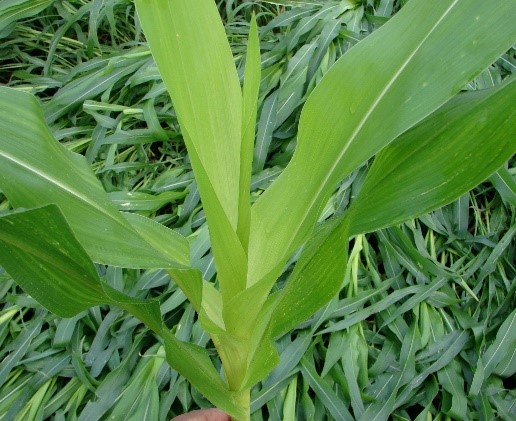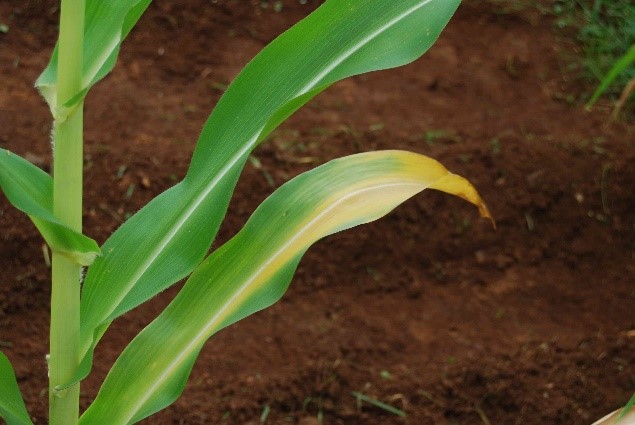
- Yellow corn fields have been appearing this spring throughout much of the FS territory.
- Sulfur deficiency symptoms appear on the newest growth, while nitrogen deficiency shows up on the lower leaves.
- In the absence of sulfur, alternate green and yellowish strips will appear on the top leaves of corn as a deficiency symptom.
- The appearance of deficiency symptoms is driven by several factors in the growing environment.
Yellow corn fields have been appearing this spring throughout much of the FS territory, largely due to sulfur deficiency. Sulfur deficiency manifests itself as alternate yellow and green strips on the newest growth, due to sulfur immobility in the plant and its role in chlorophyll production (Image 1). On the other hand, nitrogen deficiency shows up as a light green color on the lower leaves due to its mobility in the plant (Image 2). The appearance of deficiency symptoms is driven by several factors in the growing environment. These factors include the form of sulfur applied, the amount of time that has passed since application, the amount of precipitation received, the water holding capacity of the soil and the soil temperatures after application.
Most sources of applied sulfur are in the sulfate (SO4-) form, while most nitrogen applied is in the ammonium (NH4+) form. While sulfate is mobile in the soil and can move with water, ammonium cannot, as it is a cation (positively charge) that attaches to the CEC (negatively charged clay and organic matter). For a significant amount of the ammonium-nitrogen to convert to nitrate (NO3-) via biological soil processes, soil temperatures need to exceed 50⁰F and even then, the process does not start ramping up significantly until a soil temperature of 60⁰F. Soil temperature also affects the amount of mineralization that takes place in the soil. Mineralization is the biological soil process of breaking down organic matter to useful nutrient forms for the plant. Organic matter largely consists of nitrogen and to a very much lesser degree sulfur, minute amounts of boron & molybdenum and smatterings of other micronutrients. Mineralization of organic matter content in soils doesn’t increase significantly until soil temperatures reach 60⁰F. Additionally, under cold conditions, root growth doesn’t progress very rapidly which results in less access to crop nutrients.
In addition to sulfate, an alternative form of applied sulfur is elemental sulfur (ES). ES needs to be oxidized through a slow biological process to the sulfate form for plant uptake. Like the aforementioned biological processes, this doesn’t occur to any great degree until soil temperatures break the 60⁰F mark. With sulfate-sulfur, the total precipitation received after application and the soil’s ability to hold water, will determine to what depth sulfate has leached. Soils with greater water holding capacities contain higher clay and organic matter contents, while soils that hold less water against gravitations pull, are higher in sand content and lower in organic matter. At tassel, 80% of the corn roots can be found in the top 12” of soil, with the remaining 20% below that depth.
In summary, much of the light green color in corn fields we are seeing is positional sulfur deficiency. Positional means that in many fields the sulfur is out of the reach of corn roots at its current stage of growth. Unfortunately, this spring has gotten off to a cool start, resulting in slow root growth and little soil mineralization of either sulfur or nitrogen. The growing crop uses sulfur in combination with nitrogen to produce chlorophyll. In the absence of sulfur, alternate green and yellowish strips will appear on the top leaves of corn as a deficiency symptom. During this spring season, enough rainfall has occurred in most fields to move the applied sulfur below the established rootzone. Where this sulfate-sulfur resides depends on the amount of water that has moved into the soil profile since the fertilizer application. As a remedy, addition of AMS to post applied urea (caution this will cause some visual burn) or ATS to side-dress UAN, are two post applied nitrogen options. Likewise, a foliar application of liquids containing high percentage of sulfur by weight with the postemergence herbicide, can help the crop through this difficult time period. The use of ATS with post applied herbicides can cause significant crop tissue burn and should rarely if ever be done. For more information on options contact your FS Crop Specialist.
Image 1 (top right) : Sulfur Deficiency (Source: IPNI)
Image 2 (below): Nitrogen deficiency (Source: IPNI)
